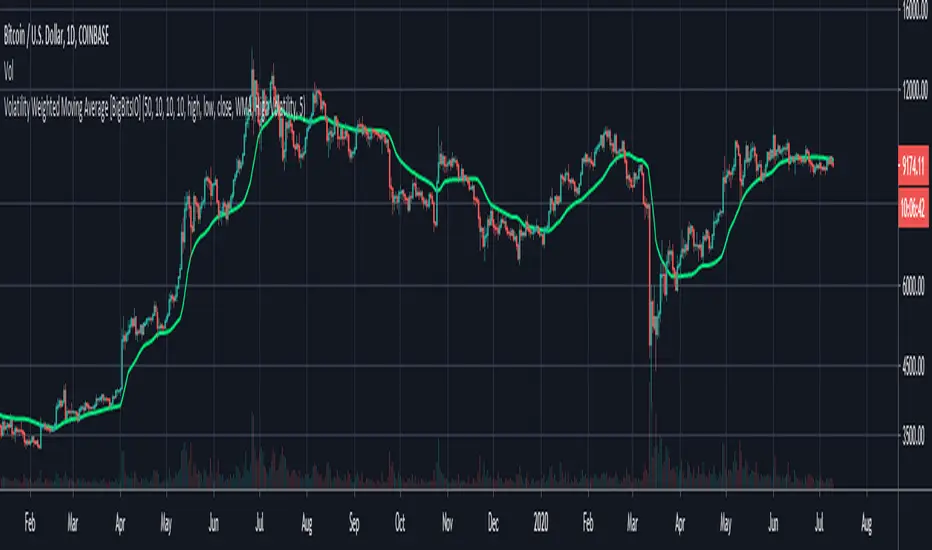PROTECTED SOURCE SCRIPT
Volatility Weighted Moving Average [BigBitsIO]

The "Volatility Weighted Moving Average [BigBitsIO]" indicator is a moving average indicator that is designed to weight certain periods of volatility more so than others, applying a greater impact on periods of high, low or average volatility. Volatility is measured throughout the volatility lookback period, and the current candle is weighted appropriately based on the indicator's weight type. Peak volatility based on the weight type is valued more to amplify the effect of the desired volatility weight.
Below are the settings used for this indicator and what they mean and do:
Why this indicator was made: I made this indicator because I wanted to visually interpret the effects of volatility on moving averages and if it could help identify any patterns in breakouts, trends, or consolidation periods.
The theory: Using a weight type of high volatility you might be able to identify breakouts with a sharp value incline or decline in slope. An average weight type would help identify trends as it could potentially reduce noise from very large and very small candles and focus more on the value of average candles - I believe for the theory on this one to work you would actually want to use less "Volatility Division" in order to include more average-sized candles in the peak weight. Finally, using a weight type of low volatility could help identify periods of consolidation.
Below are the settings used for this indicator and what they mean and do:
- Moving Average Length: The lookback period for the moving average calculation.
- Length To Measure Volatility: The lookback period to compare the volatility of the current candle to. Ex: This candle is high/average/low volatility compared to the candles in the last X candles
- Volatility Divisions: The more volatility divisions the more precise the weighting is on candle volatility. With more volatility divisions, there are typically fewer candles that can qualify as peak volatility within the volatility weight type.
- Amplify Peak Volatility In Weight Type: This is an extra weight applied to candles with peak volatility to further help weight the moving average in the direction of desired volatility.
- Start Source Of Volatility: The starting point of measuring volatility. Volatility is measured as the difference in start - end source.
- End Source of Volatility: The ending point of measuring volatility. Volatility is measured as the difference in start - end source.
- Moving Average Source: The data source of the candle when used to calculate the moving average.
- Moving Average Type: You can choose between a Volatility Weighted "Weighted Moving Average (WMA)", and a Volatility Weighted "Simple Moving Average(SMA)". The WMA and SMA respectively will somewhat resemble the actual WMA and SMA of the same moving average length, but the volatility will be weighted to shift values based on your settings.
- Weight Type: The type of volatility that should be valued most. High volatility values candles with the highest volatility, average volatility values candles that are within the average range of volatility most, and the low volatility option weights candles with the least volatility the most.
- Moving Average Smoothing Length (SMA): This will smooth the final line with an SMA. The weighting can produce jagged lines by itself, so it is smoothed slightly by default.
Why this indicator was made: I made this indicator because I wanted to visually interpret the effects of volatility on moving averages and if it could help identify any patterns in breakouts, trends, or consolidation periods.
The theory: Using a weight type of high volatility you might be able to identify breakouts with a sharp value incline or decline in slope. An average weight type would help identify trends as it could potentially reduce noise from very large and very small candles and focus more on the value of average candles - I believe for the theory on this one to work you would actually want to use less "Volatility Division" in order to include more average-sized candles in the peak weight. Finally, using a weight type of low volatility could help identify periods of consolidation.
Skrip terproteksi
Skrip ini diterbitkan sebagai sumber tertutup. Namun, Anda dapat menggunakannya dengan bebas dan tanpa batasan apa pun – pelajari lebih lanjut di sini.
Like and follow!
💻 Website: bigbits.io
📺 YouTube: youtube.com/bigbits
🎮 Discord: discord.gg/rapMn4z
🐦 Twitter: twitter.com/BigBitsIO
💸 Save $30 on TradingView Paid Plan: bit.ly/2CaRfjs
💻 Website: bigbits.io
📺 YouTube: youtube.com/bigbits
🎮 Discord: discord.gg/rapMn4z
🐦 Twitter: twitter.com/BigBitsIO
💸 Save $30 on TradingView Paid Plan: bit.ly/2CaRfjs
Pernyataan Penyangkalan
Informasi dan publikasi ini tidak dimaksudkan, dan bukan merupakan, saran atau rekomendasi keuangan, investasi, trading, atau jenis lainnya yang diberikan atau didukung oleh TradingView. Baca selengkapnya di Ketentuan Penggunaan.
Skrip terproteksi
Skrip ini diterbitkan sebagai sumber tertutup. Namun, Anda dapat menggunakannya dengan bebas dan tanpa batasan apa pun – pelajari lebih lanjut di sini.
Like and follow!
💻 Website: bigbits.io
📺 YouTube: youtube.com/bigbits
🎮 Discord: discord.gg/rapMn4z
🐦 Twitter: twitter.com/BigBitsIO
💸 Save $30 on TradingView Paid Plan: bit.ly/2CaRfjs
💻 Website: bigbits.io
📺 YouTube: youtube.com/bigbits
🎮 Discord: discord.gg/rapMn4z
🐦 Twitter: twitter.com/BigBitsIO
💸 Save $30 on TradingView Paid Plan: bit.ly/2CaRfjs
Pernyataan Penyangkalan
Informasi dan publikasi ini tidak dimaksudkan, dan bukan merupakan, saran atau rekomendasi keuangan, investasi, trading, atau jenis lainnya yang diberikan atau didukung oleh TradingView. Baca selengkapnya di Ketentuan Penggunaan.